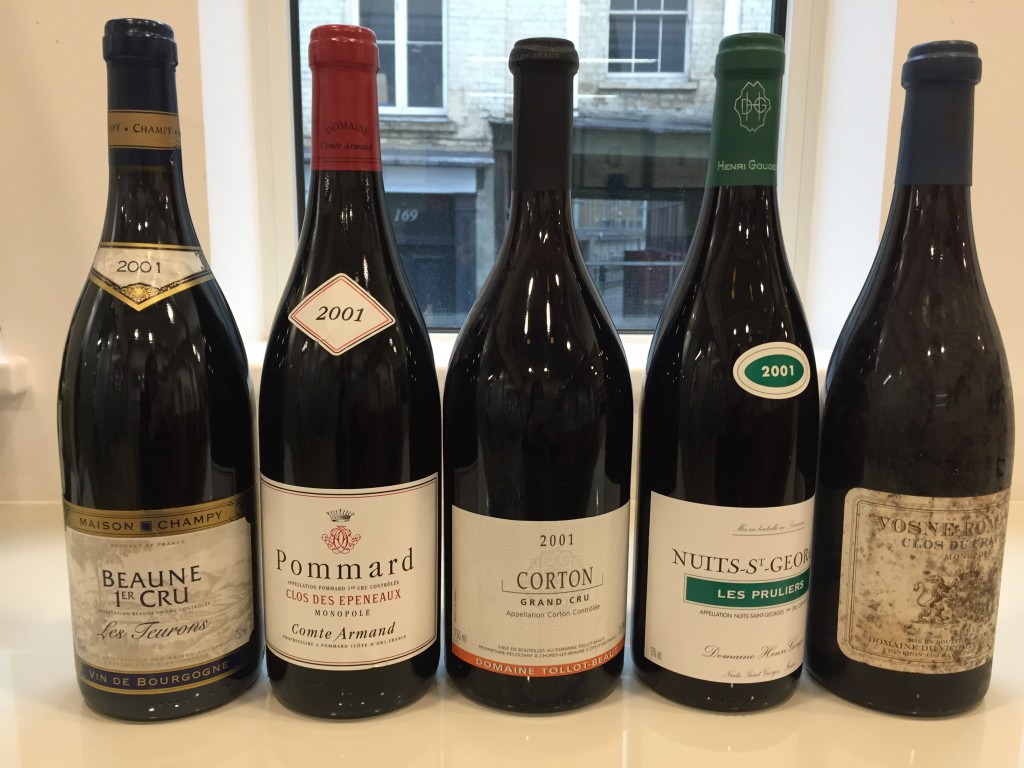2000 & 2001 red Burgundy
‘Time to Mature Tasting’
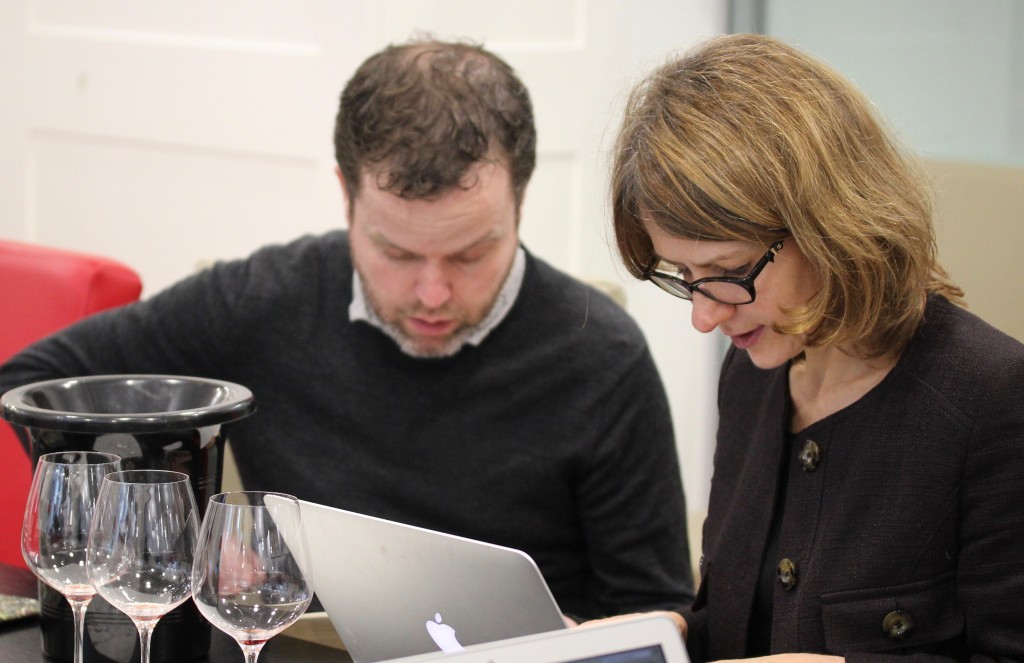
Many Burgundian vignerons would like to see their wines enjoyed with the complexity of age and are frustrated at the speed at which their top wines are consumed at home and in restaurants. They are keen to promote the idea through wine writers, sommeliers and key member of the trade of maturing red Burgundy, particularly grand cru and top premier cru. To this end, I collected a fine selection of red 2000 and 2001 on my visit last October to Burgundy and an experienced circle of people to taste them. We met for the second Time to Mature Tasting on 31st January in Bermondsey at Goedhuis & Co.
I chose to begin with the 2000 and 2001 vintages. The intention was not to cherry pick a top vintage, or to show one that might be considered to be at a perfect moment now, but to start an annual one year on tasting with wines which are fully mature. (As with the 2008 whites we tasted last year).
The early vintage of 2000 produced a red fruit vintage, always open and charming which continued to deliver with the complexity of age well past expectations, while the later 2001 vintage produced wine with more acidity, firmer tannins and more substance.
In a modest vintage, a top end premier cru or grand cru red Burgundy worth its salt should age beneficially over a decade, so how have these contrasting vintages fared after 16 to 17 years?
The wine was contributed directly from the domaines’ cellars. Bottles which have travelled and exchanged hands wil
l not be in such pristine condition.
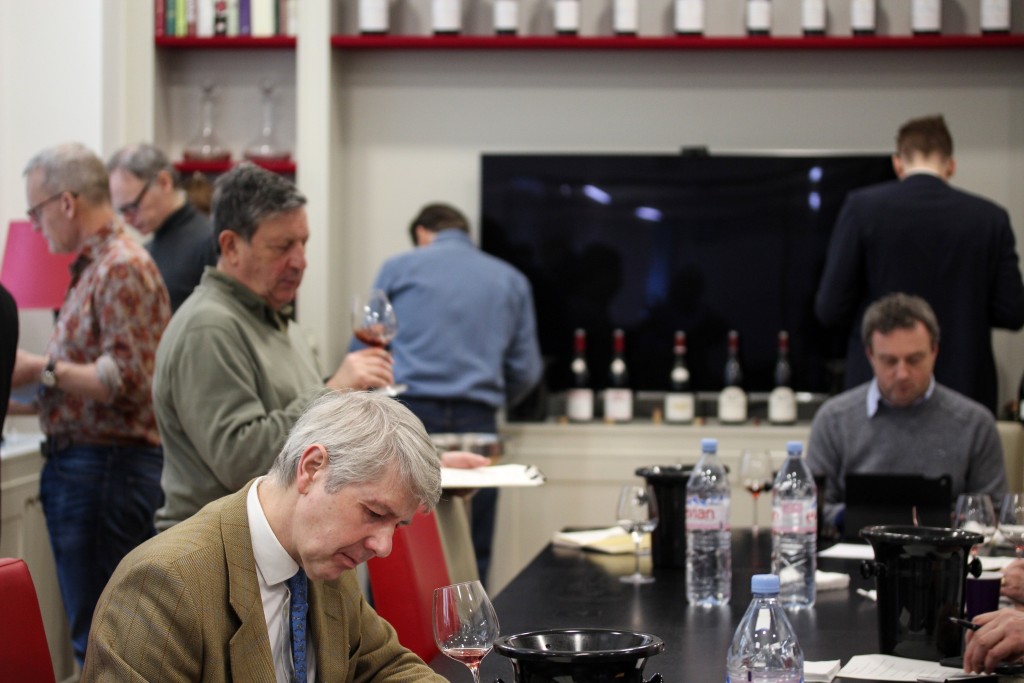
2001 Vintage
The wet, cloudy and cool season was not auspicious. July was poor. On August 2nd there was hail in Volnay and Monthelie and in Rully and Mercurey which much reduced the crop. The latter part of August was warmer, while September was cool with grey skies, but some wind helped to concentrate the fruit. Fortune favoured those who waited for harvest until after the Ban de Vendanges (17th Sept for the Côte de Beaune and 20th for the Côte de Nuits) as conditions improved after the 28th September. Maybe because of the later flowering, the vines were still photosynthesising and the fruit still ripening late in the season and it was worth waiting.
It was not a very healthy harvest and triage was necessary. Some used saignée to improve concentration. It was not a vintage to extract too much. It needed careful handing. So the potential pitfalls were over extraction, dilution and some greenness from fruit picked too early.
Yet despite the modest conditions and an early dismissiveness of the vintage, it confounded expectations, in the Côte de Nuits in particular.
The style and quality: Pure fruit and fresh acidity and nicely ripe tannins. They are trim wines with a thinner texture, but with more substance and intensity than the rounder, but less well defined 2000s. In general 2001 is not of the calibre of 2002 or 1999, but is better than 2000.
2001 Côte de Nuit wines are generally considered better than the Côte de Beaune given it received less rain in the weeks preceding and during harvest and the later picking on the Côte de Nuits. The Côte de Beaune harvested pinot while waiting for whites.
A general overview of 2001 after the tasting
(individual tasting notes follow)
2001 is fully mature. I cannot see any wine in this tasting improving with age, although some are certainly showing no sign of fading and will probably plateau quite happily for a year or three. Others are fading.
Some are quite fragile when opened and fade or dry quickly. Some lasted the three hours they were open, before we finished them off with lunch, while others started deteriorating after an hour or so. With the exception of a couple of wines, they were not decanted and the room was cool. The wines were opened between 9.20 and 9.50. I was opened the first 8 bottles – tasting as I opened and before someone took over and I had finished all but the last 5 wines by 11 when the official tasting began. This is a consideration when reading the impressions of the other tasters. I think the 2000s proved to be more robust.
The freshness of the vintage is evident and this gives these mature wines some energy. Many have a lively spring onto the palate, whether or not the energy lasted. The ‘trim’ profile is now looking quite lean.
In the wines I liked most the tannins are light. Some have a faint herbal note of stems or maybe slightly less ripe tannins, but this was actually rather nice. The best wines are those which were less extracted, where the vigneron has focused on the purity and elegance….the cooler character of the vintage. However on the flip side the lightest and most elegant wines are the most fragile and fade quickly when opened.
There are wines in this tasting where the texture and tannins are a bit rustic and the palate a touch too lean. In these wines one can only imagine that the extraction was probably over enthusiastic on fruit which was insufficiently ripe and concentrated to take it. Also too much oak. However, Pierre Damoy’s wines have more tannins than most – in both vintages, but they are also among the ripest and so the tannins are full, but ripe. The Rossignol-Trapet style is the polar opposite yet both domaines show very well in this tasting.
In general I find the palate more interesting than the bouquet in these 2001s. The nose can seem very mature – many wines had moved from the fresh woodland to coffee – maybe a bit oxidative – while the palate showed more fruit. (The colour ranges from brown to brick to orange with a wide water pale rim)
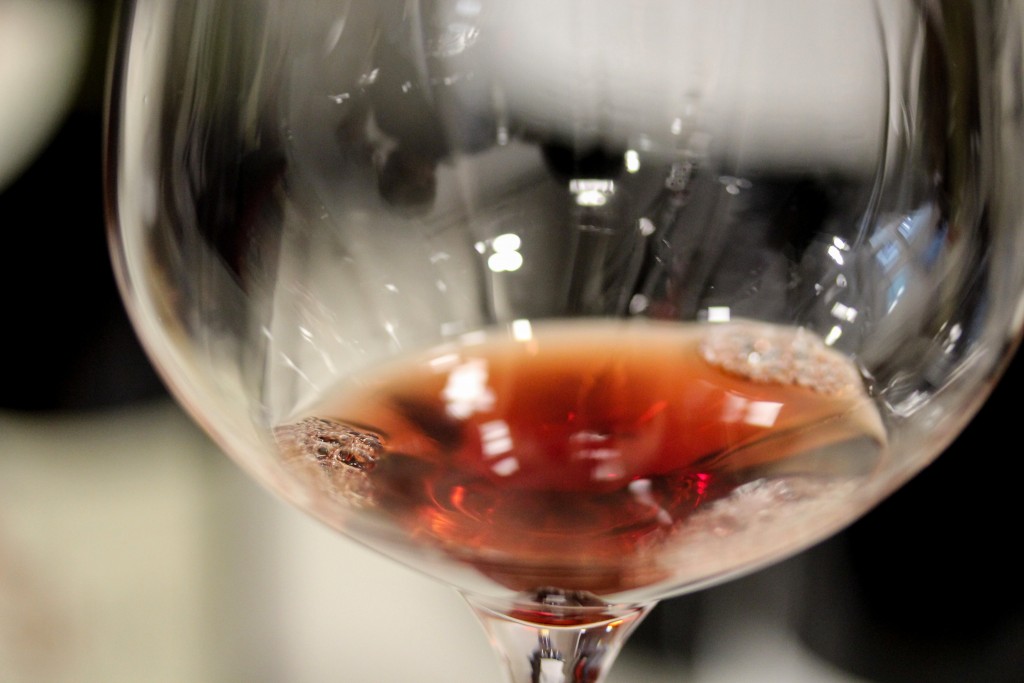
I think the wines have matured well, but for the the majority it is time to drink up. They are showing all the complexity of mature wine. The best bottles have become quite ‘intellectual’ – a vintage to contemplate and savour. There is some stunning wine – with so many grand cru this should be expected, but some grand cru underwhelmed, while it is surprising how well the three village level wines are travelling.
NB With no wine from hail affected Volnay and just three bottles from the Côte de Beaune, it’s not possible to judge whether the earlier picking Côte de Beaune was of lesser quality than the Côte de Nuits, but there is no evidence from these wines from Pommard, Beaune and Corton. They are maybe somewhat lighter in style, which is not untypical. The Beaune and the Corton have elegance and charm.
Wine which stood out in 2001
Domaine Dujac, Clos St Denis and Rossignol-Trapet, Chambertin epitomise the elegance and freshness of the vintage. The purity and thread of acidity and fine tannins are stunning.
Domaine Jacques-Frédéric Mugnier, Chambolle-Musigny, 1er cru Les Amoureuses
Domaine Michel Gros, Vosne Romanée 1er cru Clos des Reas
Two very impressive village wines – Pierre Damoy’s Gevrey-Chambertin, Clos Tamisot and Domaine Liger-Belair, Vosne-Romanée – both punched above their weight… well the former punched and the latter wafted elegantly.
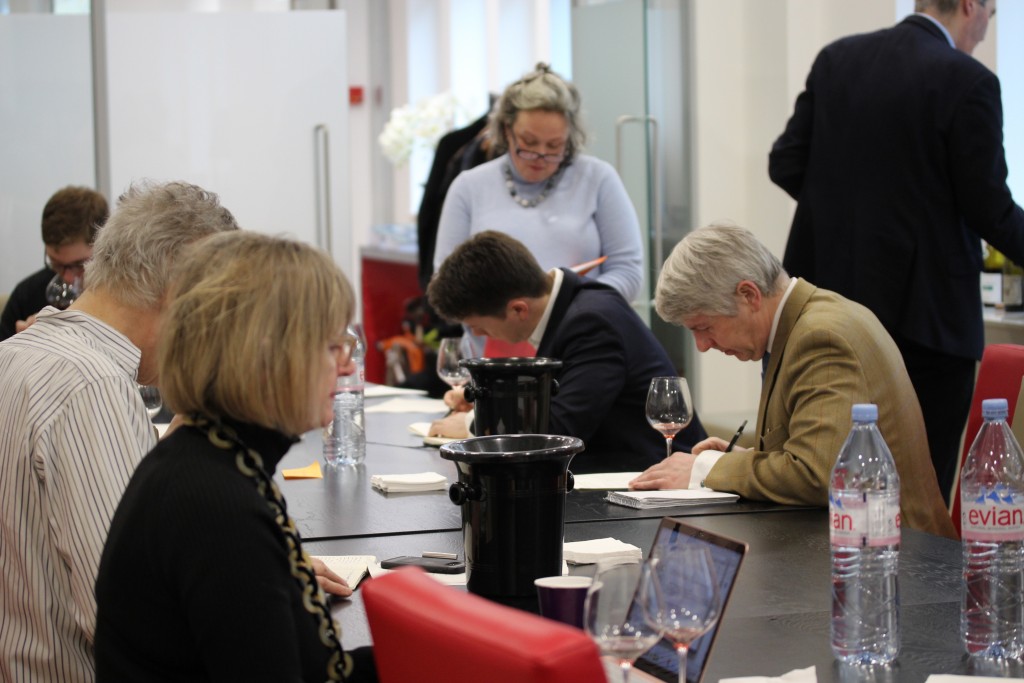
2000 vintage
The 2000 was not the greatest vintage. A cool, wet season (with less rain in the Côte de Nuits) and a mid September harvest produced a plentiful crop of modest wines that were always open and charming; a red fruit vintage which continues to deliver with the complexity of age well past expectations, possibly illustrating the point that easy, fruity vintages do not have to be consumed early.
After a meagre, cold and wet July, August was warm and this crucial month cast the sunny character of the vintage. The season started early and the Côte de Beaune began vintage on the 11th September. Sadly there was a down pour in Côte de Beaune on 12th. Volnay was notably affected with 75mm (while Meursault/Puligny were spared the worse). In the Côte de Nuits there was less rain and given that vintage is typically a week or so later, the fruit dried and they picked here with nice ripeness. The fruit had lowish acidity and thin skins.
It’s a pleasant vintage on the Côte de Nuits with plenty of sweet fruit. The style is somewhat loose knit with soft tannins, soft acidity and sweetness and aromatics of glacé cherry and ripe strawberry fields. However it is a vintage which can lack power and concentration, notably on the Côte de Beaune, where quality conscious domaines de-classified much of premier fruit to village level and kept only the best.
A general overview of 2000 after the tasting
2000 has matured well and become more interesting as the sweet fruit of the vintage… those warm strawberry and even prune flavours, have been enhanced by tertiary characters. The ripe tannins were never the finest, but are very soft and mature. I wondered about the balance and finish – but actually they are sufficiently fresh on the finish.
They are full and round and have more structure and definition – and capacity to age – than should be expected of a simple vintage. It is so appealing that the wines still have their sunny disposition.
Three of the four Côte de Beaune wines have decent stuffing and are not lacking mid palate which probably reflects a good triage. The wines are fully mature.
In the Côte de Nuits the wine is mature, but there is no hurry to drink them. Some are ready and some still need time or even decanting. The ripe fruit gives plenty of sweetness on the finish. The 2000 is more lively than expected, but does not have the fresh line or as long a finish as 2001.
Maybe I expected to be more impressed. I think my expectations have become too high for I have enjoyed some lovely bottles of 2000 and it’s only the surprise that this simple vintage can deliver so well that is waning – or perhaps in comparison with the 2001, the lack of complexity was more evident.
Wine which stood out in 2000
Domaine Jean Tardy, Clos de Vougeot
Domaine Georges Mugneret-Gibourg, Ruchottes Chambertin
A comparison of the two vintages
2001 is a vintage with precision and definition. I like the lightness and the purity and freshness. They can be a little lean and some – even grand cru – are drying. Some tasters preferred the 2001s for the freshness. Those who preferred the 2000s seemed to have quite a strong antipathy to the 2001s finding them too lean. While those who preferred the 2001s, also liked the 2000s, but favoured the 2001s for the acidity and energy.
I liked both, but the 2001s had the edge. I found them more complex, layered and just more captivating on the palate. (However I felt the bouquet on the 2001s was becoming too old and I preferred the nose on the 2000s).
It was a good opportunity taste the same cru from the same domaine side by side. I was impressed that the 2000 was fresher than expected but I tended to prefer the 2001 for the liveliness and precision.
It was interesting that the 2001s were more mature than the 2000s. There was an overall sense of fragility. I would drink the 2001s. While I think the best 2000 might well last longer.
Maturing red Burgundy
I think this tasting illustrates that red burgundy ages longer than you might expect. Few would have set out to age 2000 for nearly twenty years and while the 2001 Côte de Nuits had the better reputation, it was never a top vintage with expectations of long cellaring. And yet wine from these producers has stood the test of time and they are not merely hanging on, they are, for the most part, greatly enhanced. With age they have become wine which weaves an intriguing tapestry of flavours on the palate. The simple 2000 has developed more layers and complexity, while the 2001 tantalises… its nervy palate now scented with the intricate and enticing aromas of a fully mature wine. And it is for this that we wait. I feel that we who are fortunate to taste and appreciate fully mature vintages, have some obligation to pass on this message and support the Burgundians in their mission to encourage Burgundy drinkers to make time to allow wine from good and great terroir, to shed its often engaging youthful character to reveal something more.
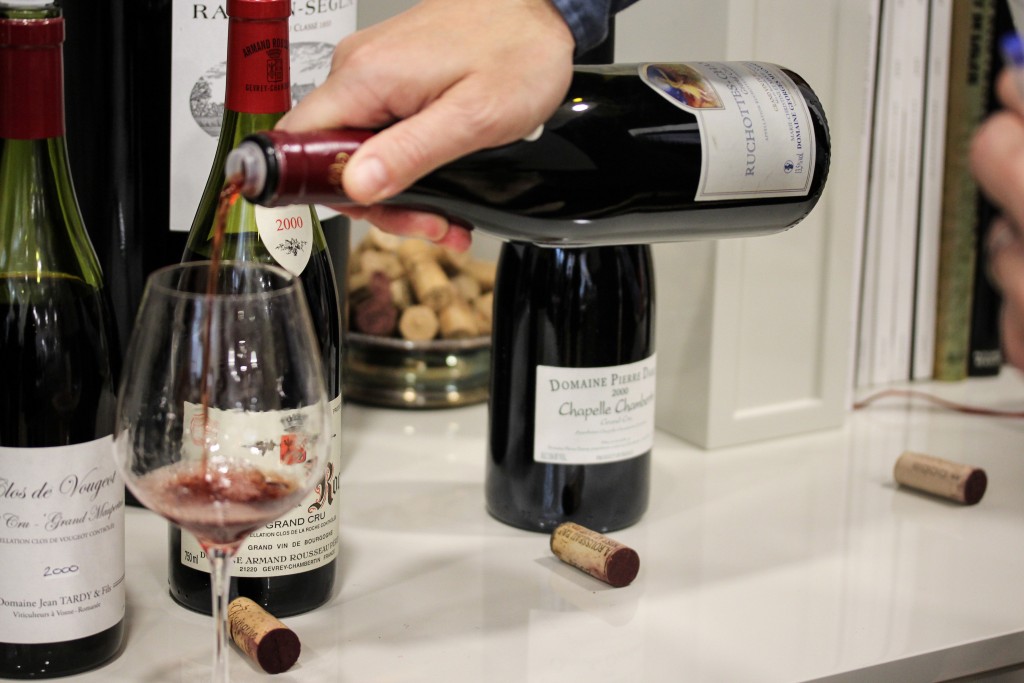
General observations
I was struck by the stylistic difference in the wines of some domaines 17 and 18 years ago in comparison with the wines from the same domaines now. In terms of ‘style’ the winemaking approach has significant impact, maybe not far behind that of the vintage itself. (By the same token today’s meticulous triage has a significant effect on quality in recent lesser vintages). Many domaines have worked progressively towards a more elegant style with less extraction – for example Domaine Gouges and Humbert Frères. There was less sensitive use of oak at the time – not just new oak, but choosing oak to suit the terroir – Faiveley’s wines are transformed by the winemaking of Jerome Flous and the change in oak.
This is not true throughout. Other domaines are instantly recognisable by their style, which is essentially the same today- the light and airy style of Frederic Mugnier or luscious fruit and rich style of Pierre Damoy.
In the 17-18 intervening years it’s also worth bearing in mind the improvements in the vineyards with many moving into or towards organic management (or mindful lutte raisonée with use of synthetic fungicides rather than copper sulphate) and some including Rossignol-Trapet becoming biodynamic…Nicolas and David had recently taken over with these vintages and their ‘light’ touch is clearly apparent, but the changes in the vineyards take time to filter through. Yields will be lower too – significant for ripening in cooler vintages such as these.
All these factors will influence the intensity, concentration, acidity, the texture of the tannins and well the style – irrespective of vintage. Most, if not all of the domaines, would make a better and somewhat different wine if they were to make wine today from a season like 2000 or 2001.
As a final thought, I think the reputation of both vintages suffered a little from being sandwiched between the celebrated 1999 and 2002. 2000 was rather overlooked as many splurged in buying the excellent 1999 and reined back maybe in buying 2000 and while 2001 was soon recognised for its quality, the beautifully balanced 2002 hogged the limelight.
Tasting Notes 2001
Côte de Beaune
*denotes wines I particularly enjoyed.
Maison Champy, Beaune 1er cru Les Teurons
Paling hue. Forest floor. Smoke. Lively attack. Light texture. Elegant. Very fresh acidity. Pure fruit on the finish. Straight and mineral. Drink now. Score 16.85
Domaine Comte Armand Pommard 1er cru, Clos des Epeneaux
Orangey-brown hue. Generous fruit at the front. Dense and quite juicy. Full in the middle. Smoky notes. The finish has a warm asphalt note. Decent length. Quite robust. It’s good, but just not quite as elegant as I would have expected. Score 17.45
*Domaine Tollot Beaut, Corton
A very sweet aroma for 2001. Mulberries, wet leaves and rose petals. Very appealing. Smooth and sweeping onto the palate. Maybe a little ‘light’ but it has sufficient stuffing and appealing fresh acidity. It is reasonably long on the finish. Lovey balance. Drink now Score 17.85.
Côte de Nuits
Domaine Henri Gouges, Nuit-Saint-Georges 1er Les Pruliers
Quite brown with a wide water pale rim. This has a compact nose. It needs time to open. Coffee and straw and vanilla. Springs onto the palate. Very lively up front. Somewhat lacking mid palate, but better on the finish. At the end touch of coffee and marmite. The tannins are quite firm and grippy even now. I expected more. Fully ready. (Opinions were really quite divided on this wine). Drink now and drink up. Score 15.5
*Domaine du Vicomte Liger-Belair, Vosne-Romanée, Clos de Chateau
Light intensity of rose petal, just a waft on the nose. More going on in the palate. Here there is a lovely fragrance. It is very pretty. Silky tannins. Balanced and fresh. Much more than I expected on this village wine. Scented finish too. Top notch village. Score 16.5
*Domaine Michel Gros, Vosne Romanée 1er cru Clos des Reas
This has a full and intense nose. Inviting ‘stable’ aromas. Rich woodland on the front of the palate and sweet fruit across the palate which is laced with light and fresh acidity. Beautiful balance. Ageing very well indeed. It will continue to evolve nicely for it is ‘youthful’, but for me it is at a perfect stage now – a lovely balance of fruit and tertiary characters. Very svelte and elegant. So drink now, but no hurry. Score 18.25
*Domaine Mugneret-Gibourg, Chambolle-Musigny 1er cru Les Feusselottes
A light bouquet of rose hip and dry bracken. Delicate, fragile and refined on the palate. It is pure and has lively acidity. Light and delicate tannins…lovely long finish. Delicate and delicious – the acidity carries this wine and there is an almost a herbal note which is very attractive. Beautiful now. No sign of fading. Score 18.25
*Domaine Jacques-Frédéric Mugnier, Chambolle-Musigny, 1er cru Les Amoureuses
Pale orange hue. Light aroma of wild herbs and forest floor. Pure and lifted. It is light and floats across the palate to a sustained and ethereal finish. Wonderful. Epitomises the best of 2001 – the light and elegant tannins; the freshness and the purity. However it does not last. It was lovely when I opened the bottle, but going back just 60 minutes later was fading fast and 2 hours later it was almost gone. This is disappointing…if it had sustained the first impression it would have been a highlight of the tasting. Drink now. I scored it 18.75, (but that was for the moment it was opened. 2-3 hours later it would have scored Score 18.25)
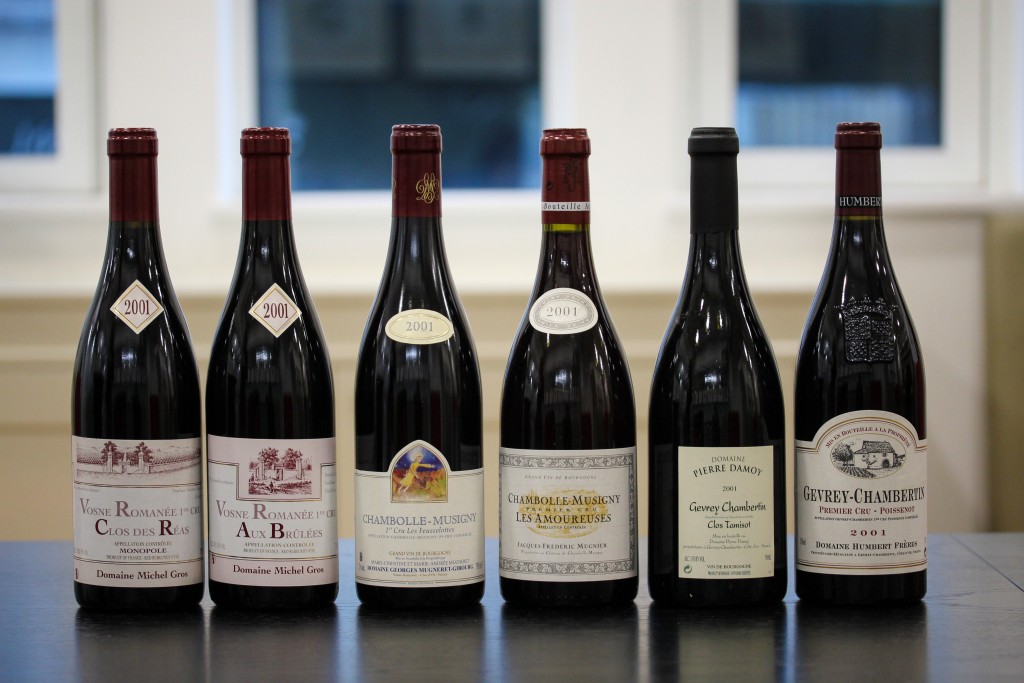
*Domaine Pierre Damoy, Gevrey-Chambertin, Clos Tamisot
A browning hue with water pale rim. Full and quite sturdy bouquet. Punchy on the attack. Plenty of fruit here. Tertiary notes of coffee, toasted hazelnuts together with prunes. A burst of fruit – chocolate and prune at the end with some freshness. Top notch village wine with plenty of life in it. This wine is not declining. Score 16.5.
Domaine Humbert Frères, Gevrey-Chambertin, 1er cru Poissenot
Coffee notes on the nose, but not a lot showing. This is rather juicy on the attack after the quiet nose, but not much mid palate or on the finish. Fully mature with dark chocolate and touch of mint maybe. Maybe past its best. Score 14.5.
Domaine Humbert Frères, Gevrey Chambertin, 1er cru Les Estournelles St Jacques
Coffee brown hue. Earthy bouquet. Much more interesting than the Poissenot with more depth and a dark, earthy character. Freshness and energy here too. Holding itself well. Not the longest finish, but with fruit and flavour. Drink now. Score 17.
Domaine Humbert Frères, Gevrey Chambertin, 1er cru Les Petite Chapelle
Brown hue. There is an edge of sweetness on the nose. Some density and juiciness. Maybe a tad longer than the Estournelles, but I prefer Estournelles for its slimmer and more lively character. This is broader and more robust. Drink now, but no sign of fading. Score 16.5
(The winemaking was more extractive at this domaine in 2000 and 2001. The style has evolved with Emmanuel using a lighter touch, pursuing a more elegant style. So these wines are not really representative of the quality and style now, which is much improved.)
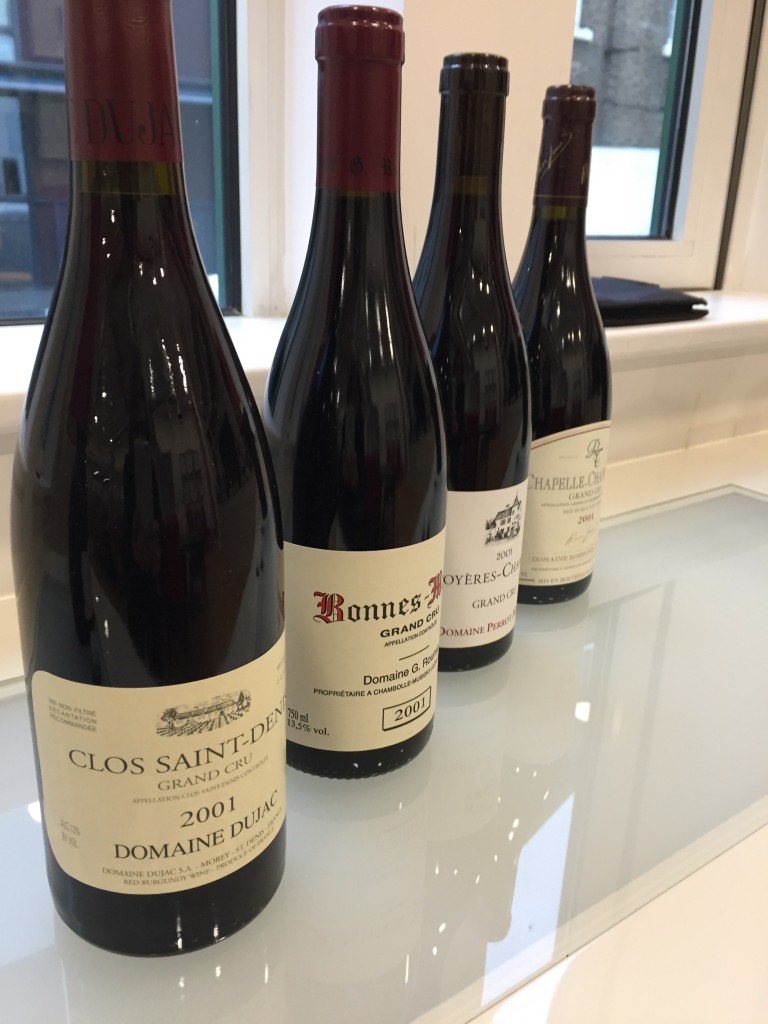
*Domaine Dujac, Clos St Denis
Coffee and smoke. Touch of bonfire also a herbal note…attractively so. A very elegant palate, which sweeps pure and svelte. There is a smooth and fine weave to the texture, which is lightly threaded with acidity. Lovely long and pure finish. Just beautiful. Drink now, but feels as though it is on a plateau. Score 19
*Domaine Georges Roumier, Bonnes-Mares
This has a tertiary aroma with woodland, hay and grilled nuts. It really pushes through on the finish…it’s actually quite tight and might benefit from some air. On the very end it is very aromatic with a rose petal perfume. A lovely finish. So we decanted this and after decanting the palate opens to show the finer tannins and elegance with a light and delicate sweetness on the finish. Drink now, but decant. Score 18.65.
Domaine Perrot-Minot, Mazoyères-Chambertin
Potent aroma… surprisingly strong and funky with sweet stable notes. However it is quite fragile on the palate. It is scented with a ‘lightish’ body for this grand cru and silky tannins. Nicely fresh, pure and aromatic on the finish. Delicacy of structure and texture It was lovely when opened, but a couple of hours later was rather dry. Drink now and drink up. Score 18.25
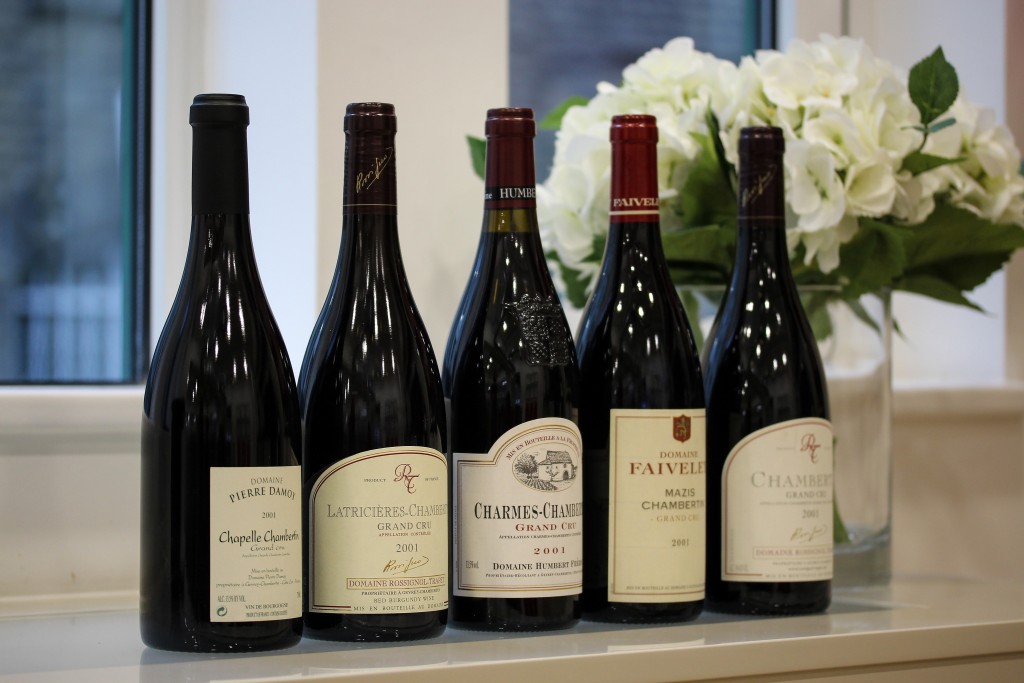
Domaine Rossignol-Trapet, Chapelle-Chambertin
Very open and appealing with sweet hay and peony. There is a freshness on the front, a chalky tension and a little grip. The tannins are quite edgy. There is ‘large’ structure, but sketched lightly. A light salty mineral on the finish. Drink now. Score 18.45
*Domaine Pierre Damoy, Chapelle-Chambertin
Sweet stable bouquet. Full on the strike, very juicy. Deep mid palate with black fruit and notes of bitter chocolate and earth and leather. It has a firm layering and a punchy finish. The finish is long and has a touch of spice and dried fruits. This is still evolving. Score 18.65
*Domaine Rossignol Trapet, Latricières-Chambertin
Delicate and fragrant. White flowers and earl grey tea. Bergamot. Very pure, linear, swift and fine palate. This is crystal clear – fine streaming…the finish is salty with a sappy minerality. Long, but a touch dry at the end. I really like it, but feel it may be nearing end of its life. Score 18.5
Domaine Humbert Frères, Charmes-Chambertin
Plenty of fruit on the nose. Damsons and prunes and spice. A thicker texture than typical of the 2001s in the tasting. There is succulence coating the tannins. Burly and just not that layered. The finish is fair. Score 17.
Domaine Faiveley, Mazis-Chambertin
Very stably. This is really juicy and energetic on the strike. It is quite smoky. Plenty on the front of the palate. So impressive up front, but quite lean in the mid palate. The tannins show a little, not too overtly, but I think it may be drying and the oak is showing. The finish has notes of dark smoke… it is quite long, but a little boney. Score 18
*Domaine Rossignol-Trapet, Chambertin
Lovely sweetness to the nose. This sweeps across the palate. Very precise. Lovely definition, purity and intensity. A very long and complex wine. It is restrained and layered and very fine indeed. It will go on. The finish has sweetness threaded through. No hurry here. A highlight of the tasting. Score 19.
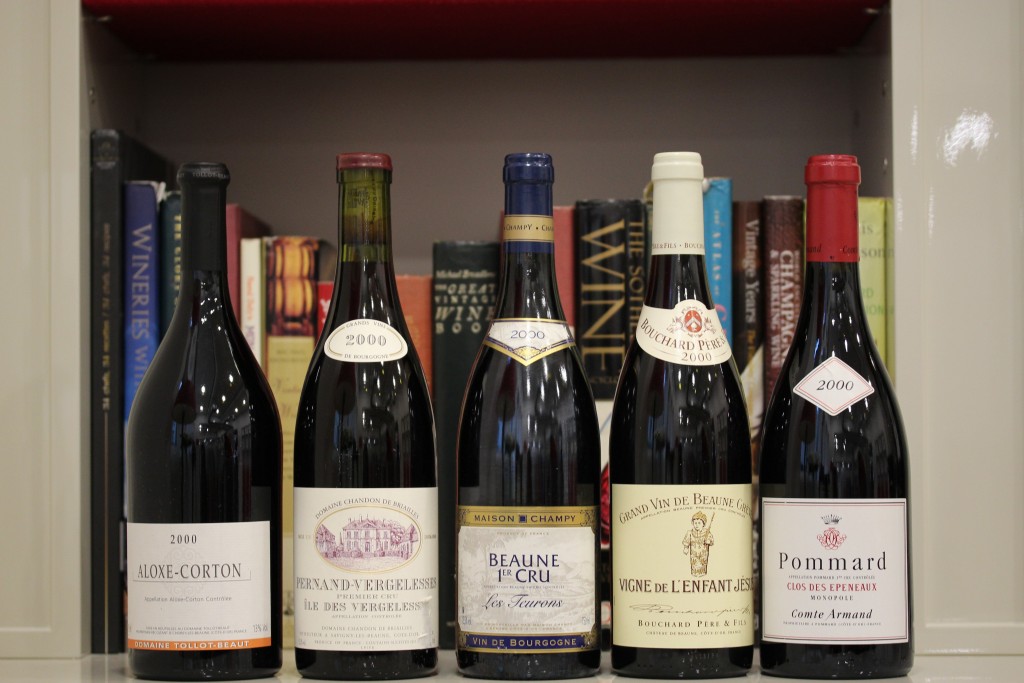
Tasting notes 2000
Côte de Beaune
*Domaine Tollot-Beaut, Aloxe Corton
This is sweet and forward; soft, rounded. Plenty of the mid palate, not much on the finish but actually it is really very nice indeed. Can’t ask more than this of a village wine. Score 15.
Domaine Chandon de Briailles, Pernand Vergelesses, 1er cru, Ile de Vergelesses
Touch of brown in the fading colour. Bouquet of coffee and warm asphalt. Quite a medicinal character, not unpleasant. The flavours are quite herbaceous, but the tannins perfectly integrated. The wine is quite austere for 2000. Interesting, but I don’t think it will improve and would drink now. Score 16.75
*Domaine Bouchard Pere et Fils, Beaune, 1er cru Grèves, Vignes de L’Enfant Jesus
Attractive fresh mushroom bouquet with a hint of orange peel. Juicy and rounded. Plenty of concentration and some good energy too. This is a very good 2000. It is maybe a tad shorter than expected, but a lovely balance of fruit and supportive tannins and just nice acidity. Appealing. Drink now. Score 17.75.
Domaine Comte Armand, Pommard 1er cru, Clos des Epeneaux
This is fruity, open and juicy. Summer fruits. The wine is still quite youthful. Not a subtle wine. There are plentiful, but soft tannins. I like the fact it retains some of the fruit with more evolved characters. Well balanced. Good firm finish of modest length. It has an honest forthright palate. I like it… may be more than 2001 Clos des Epeneaux. Drink now, but I am not sure there is much to be gained in keeping it. It is not showing quite as well as the bottle I tasted a year ago (Score 18). Score 17.75/18.
Côte de Nuits
Domaine Michel Gros, Vosne Romanee 1er cru Clos des Reas
Sweet stable aromas and strawberries on a hot day… a heady nose. Sweet on the attack. Soft integrated tannins. It has aromatics on the finish. It is lovely and full and upfront, but not as fresh, long and precise as the 2001. Drink Now. Score 17.75.
*Domaine Michel Gros, Vosne Romanee, 1er cru Aux Brulées
Ripe nose, but cooler and more restrained than Clos des Reas. Edge of smoke. Plenty of ripe fruit, but also some reserve. This contrast is pleasing and there is some tension here for 2000. Very well balanced. Drink now and over the next few years. No hurry. Score 18.25
Domaine Jacques-Frédéric Mugnier, Chambolle-Musigny, 1er cru Les Amoureuses
This is sweeter than the 2001 which has a more coffee aroma. Open and fragrant with the warm notes of the vintage on the light, billowing palate. A heady perfumed finish. Long and airy. Score 18.35. However in comparison with the 2001 it does not have the precision or the length or the intensity.
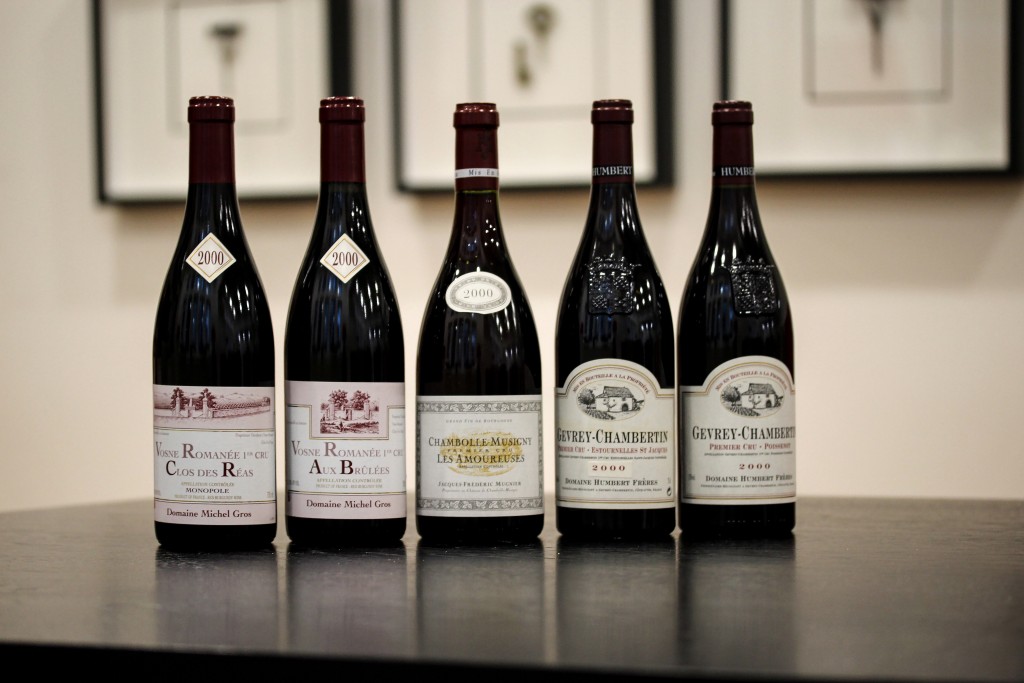
Domaine Humbert Frères, Gevrey-Chamberton, 1er cru Poissenot
It is juicy, full and open. Plentiful fruit. More glycerol and succulence than 2001 Poissenot. The vintage is better suited the style they were making at the time. It needs decanting for it is quite concentrated and robust. It’s an honest wine. Score 16.5
*Domaine Humbert Frères, Gevrey Chambertin, 1er cru Les Estournelles St Jacques
This is the fresher of the two Humbert Frères wines. This is much more elegant than Poissenot. Ripe fruit is balanced by nice acidity. The tannins are smooth. It has texture and richness and freshness. Sweet evolved characters. Drink now, but no hurry. Score 17.25
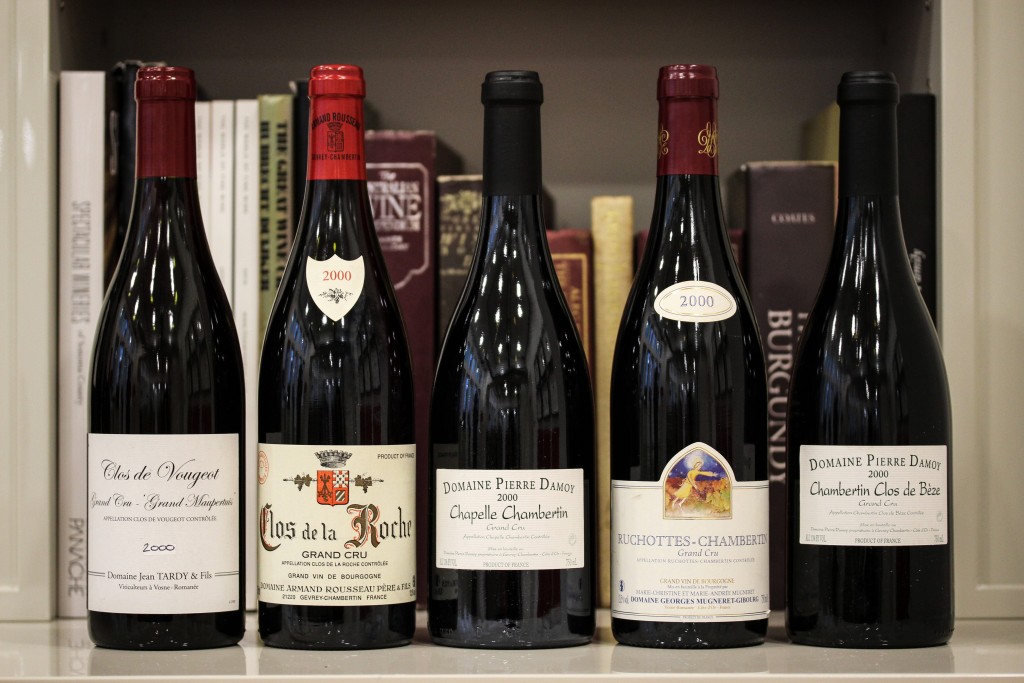
*Domaine Jean Tardy, Clos de Vougeot
It is svelte, full and rounded. Depth and density. A rich palate with a ripe tannic structure rather than the acidity to support it. It is quite powerful. There is a bullish character, cloaked in sweet fruit. A long and quite muscular on the finish. Drinking very well now, but looking as though it has plenty of life in it yet. Really rather good. Score 18.65
Domaine Armand Rousseau, Clos de La Roche
This is just delicious and vibrant on the attack, spice and caramel and forestry notes. Surprisingly fresh. It is quite florid but energetic. Extravagant, but not layered. The finish is quite long and exotic. This is lovely now and on a plateau Score 18.25
*Domaine Pierre Damoy Chapelle Chambertin
Sweet, strong and stable. Hoofy notes. This has good firm structure and freshness. It is ripe, but has unexpected vibrancy. The finish is maybe a touch drier after the sweetness of the palate, but gives a good contrast. I would say drink now as the mid palate is so attractive. Score 18.55
Pierre Damoy, Chapelle-Chambertin 2000 and 2001 tasted side by side
2001 has an more evolved coffee bouquet while 2000 is sweeter and fruitier. 2001 is fresher on the palate and more energetic, while 2000 full and rounded and succulent.
*Domaine Georges Mugneret-Gibourg, Ruchottes Chambertin
Restrained, salty. Red fruits, airy. Delicate, pure and high toned. This is delicious and beautifully balanced. The finish is long and mineral and lightly swathed in fruit. It has a purity in this warm vintage. This is wonderful and evolving still. Score 18.95
*Domaine Pierre Damoy, Chambertin, Clos de Bèze
Seductive. Tertiary characters blend with ripe plum and ripe black cherry and spice. This ripe, full and ‘full-on’ luscious style is trademark Damoy and he does it with panache. Plenty of substance with smooth rich tannins and viscosity. It’s soft with just enough acidity to balance and a succulent finish. I think many people will love this exotic and spicy wine… and what’s not to like? Drink now, but no hurry. Score 18.7
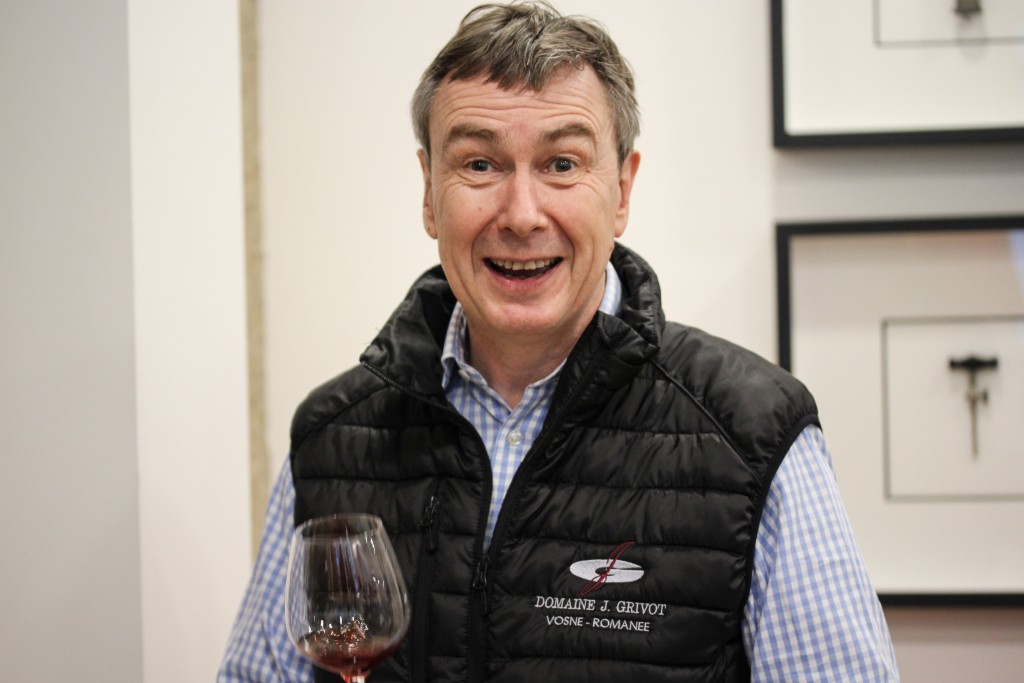
David Roberts MW of Goedhuis & Co who kindly co-hosted the tasting
The impressions of my fellow tasters.
With the wine writers, where possible, I have made a link to their article or given the publication.
Writers
Jancis Robinson MW for the FT
Article for the FT Friday 15th February available on JancisRobinson.com and FT.com
Neal Martin for Vinous.
“I actually thought the 2001s were more mature than I expected and I came away with the impression that they are not for long-term keeping. I needed more fruit and body. So I had low expectations going into the 2000s but hey ho, I was pleasantly surprised (lovely Chandon de Briaille for example, ditto Ruchottes). There were a few there that I think will keep for a few more years, but not like say the 1999s or best 2002s.”
Neil Beckett MW for The World of Fine Wine
Tim Atkins MW will be writing a piece for Decanter (Expected date of publishing 5th February)

William Kelly for The Wine Advocate
Stephen Brook
A fascinating tasting. 2 difficult vintages, with rot in both years. So selection was essential in order to produce good wines, and this favoured the more quality-conscious domaines that were generously represented here. In many cases I tasted these wines in their youth and was often disappointed. With time they have gained in complexity, although they are almost all ready to drink. It would be difficult to say which is the ‘better’ of the two vintages given this fairly limited selection, but I gave ore high scores in 2000, although Roumier’s Bonnes Mares and Rossignol-Trapet Latricieres in 2001 were both magnificent, with Dujac’s Clos St Denis and Gouges’ Pruliers and Mugneret-Gibourg’s Feusselottes hot on their heels.
Most of the wines had delectable aromas, with pure and fragrant raspberry fruit, sometimes with a hit of redcurrants too suggesting alack of optimal maturity. On the palate they were less consistent, especially where extraction had been pushed too hard. So there were disappointments, especially in 2001. But the best 2000s were splendid, although they are almost all ready to drink and are unlikely to benefit from further cellaring. Some will stay on a plateau, I expect, for some years to come. My favourite 2000s were from Bouchard, Michel Gros, Mugnier, Mugneret-Gibourg, and Damoy. Damoy, indeed, was one of the surprises of the tasting. With his late-picked style and fearless tannins, one wonders how well they will age, but these 2000s were still going strong (the 2001 Chapelle less so). Another surprise was Rossignol-Trapet. When young these wines can seem light, even Grands Crus. Although the 2001 Chapelle was fading fast, the Latricieres was impressive.
Overall the tasting reinforced my impression that Burgundy from a top producer is worth cellaring, even in lesser vintages, allowing more complexity to emerge. A wine easily dismissed in its youth can blossom with a decade or more in bottle. But of course the wines needs to be balanced from the outset.
Sommeliers
Xavier Rousset MS (Cabotte)
Xavier prefers the 2001 “It has more personality. For my sins I like more acidity. It has acidity, but also greenness. The not so pretty vintages can be a little austere and harsh. The 2001 has the edge though. I think the tannins will get harder and harder and the fruit starts to disappear and they will become not charming. I thought that the wines were not fading at all, but there was no real reason to age them.”
Terry Kandylis MS (Head Sommelier 67 Pall Mall)
“I expected 2001 to be more to my liking and this tasting confirmed it. It has fruit, acidity and nerve. One of my favourite wines is Tamisot 2001. Lovely for a village wine and it would be great value for money. Dujac, Clos St Denis is my best wine. I like Roumier’s Bonnes-Mares too. Now it is made with more stems, but this was good. Perrot-Minot, Mazoyères has beautiful fruit. It is very well balanced and shows great finesses.
For the 2000s Jean Tardy Clos Vougeots is a very good example of the vintage and with Damoy’s Chapelle are my two favourite 2000s. The Chapelle has almost cooked fruits. Damoys wines are ready now both the 2000 and the 2001they have savoury, earthy notes. Rousseau Clos de la Roche is the least favour of the grand cru. It is missing the layers of Rousseau’s other wines. Mugneret-Gibourg’s Ruchottes still needs time, but the 2000s are generally are at their peak now and are not for the long run, while the nerve of the 2001s will make them more long lived.
Stefan Newman MS (Head Sommelier at Dinner by Heston)
Overall very, very good and they show well. Some producers I have a personal preference for. Tollot-Beaut and Gouges always sell well and Roumier. I like older Damoy Wines (which I buy from Flint) and it’s good to see how well they age. They are reliable and even in not great vintages they are showing well. They take time to open up and I appreciate this about Burgundy – and this is true of Damoy..his style is tight in youth and it peels back layer by layer. I prefer his 2001. In general 2001 is fresher, has more structure and carries its weight beautifully and is so fresh for a 17 year old vintage, while 2000 there was more heat and therefore more development so it’s different in character. I personality think 2001 is what I look for… pure and fresh and still lovely pure fruit. Beautiful window now for drinking the 2001.
Gearoid Daveney MS (Flint and Cabotte)
“I will start with my preconceptions. I thought I may like the 2001 more, and this proved correct. In 2001 I like the freshness. If you want ripeness and generosity, it’s not for you. I particularly liked Michel Gros and Mugneret-Gibourg. Humbert Frères struggled across in both vintages. For the 2000s, they were lacking flavour and depth and were a bit oxidative. A bit tired. In general the 2001 vintage has more energy, while 2000 lacking and oxidative. However I also found 2001 Rossignol-Trapet Latricieres a bit oxidative.
My favourite wines in 2001 were Michel Gros Clos de Reas and Mugneret-Gibourg, La Feusselottes. Dujac Clos St Denis and Roumier Bonnes-Mares were good expressions of cru and Damoy Chapelle showed well and Rossignol-Trapet Chambertin was good.
In 2000 there was good structure in Clos des Epeneaux. Mugneret-Gibourg Ruchottes was very good but probably pricey. And Clos de La Roche good, but not a highlight.
Elvis Zoacos (Head Sommelier at the Greenhouse) felt the 2000s were much better than the 2001s which he felt were a bit thin and lean and the 20001 1er cru in particular were drying, while he found the 2000s had viscose texture which he really appreciated and richer fruit. He felt these would be much more interesting for his customers.
Trade
Goedhuis & Co. David Roberts MW and Catherine Petrie MW.
This is the link to Catherine’s blog on the tasting.
Charles Lea (Lea and Sandeman)
The 2001s are often quite nervy, and if I’m honest, some probably mildly disappointing. One thing that stood out for me was that there was really quite obvious oak on quite a lot of the wines, which was a surprise after 16 years. Some seemed young, others had lost fruit and were very drying on the oak tannins. My overall feeling at the end of the flight was the thought that winemaking has moved on substantially in the last two decades.
The 2000s, a lower acid vintage, is an interesting comparison – velvet tannins, fleshy, quite thick mouthfeel, but inclined to be shortish. But in terms of easy hedonism, possibly easier to understand than the rather taut dry if longer 2001s – but the best 2001s were more stimulating, I felt.
In only a few of the wines was much sign of the effortless grace or natural fresh ripe balance that gets me most excited in Burgundy – there was a bit too much effort evident in many.
I was rather happy with the performance of the 2 growers I had represented there – Mugneret-Gibourg and Perrot-Minot, but I know others preferred different wines, so I think that does rather say the old obvious thing that not everyone likes exactly the same sort of wine!
Sebastian Thomas (Howard Ripley)
These two vintages have always been close to my heart: 2001 because I loved it from the start, and 2000 because I did the vintage at Domaine de l’Arlot.
The best 2001s have kept their pure, delicate fruit, and were as appealingly understated as ever. I heard some influential tasters commenting on how there was nothing in the room that wowed them. On the contrary: a quiet Pinot can be just as enchanting as a ripe brash one. Some of the wines, of course, had not held up, crushed by tannin or oak, but the Mugnier Amoureuses, the Armand Epeneaux, the Roumier Bonnes Mares and surprisingly the Faiveley Mazis were all shining examples of wines that were à point with plenty of life ahead of them. I was anticipating the 2000s to be far more advanced. It was always thought of as an early drinker, but many of the examples here confounded that expectation, which given the rot and poor weather was surprising. The best ones had sweeter fruit than the 2001s, and less pronounced tannins, but they also had less precision. Stars here were the Armand Epeneaux, the Rousseau Clos de la Roche, surprisingly the Champy Beaune, and head and shoulders above the others, the Mugneret-Gibourg Ruchottes. Why would I advise customers to age red Burgundy? Because the best ones smooth out as they age. They lose the fruity exuberance of their youth, become subtler, more integrated and transparent.
Amanda Skinner (Private Cellars)
Richard O’Mahony (Atlas Wines)
This wonderful tasting certainly illustrated the ability of red Burgundy to age, with wines from these two less lauded vintages showing complexity and, in many instances, lovely harmony. Significantly, and much discussed in the room were the huge strides forward in terms of viticulture and vinification, attitudes to fruit health and ripeness, selection and the general increase in attention to detail that we see and hear of as having taken place in Burgundy over the last couple of decades. What would have been produced, and with what longevity, from similarly challenging vintages nowadays?
Overall, I felt that the 2001s were more fragile and less consistent than the 2000s. That said the peaks in 2001, the wines that managed the challenges of the vintage best, were superior to anything on show from the 2000 vintage. Dujac’s Clos-St Denis 2001 was a real stand out, showing the purity and elegance one would hope for in the vintage. But I also thought that the 2001 vintage was one in which the terroir came through; Grand Cru wines were a notable step up in general quality and consistency, even while stylistic differences between domaines remained evident. This was heartening and great credit to those vineyard-mapping monks… The 2000s seemed safer, more solid but therefore also perhaps lacked the ability to shine. That said, based on these examples, they possibly have a few more years in them compared to the more drink-now 2001s and should continue to give pleasure.
Charles Taylor MW (Charles Taylor and Montrachet)


